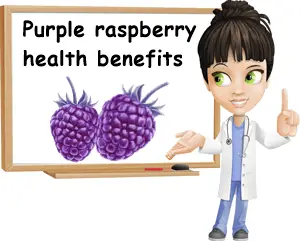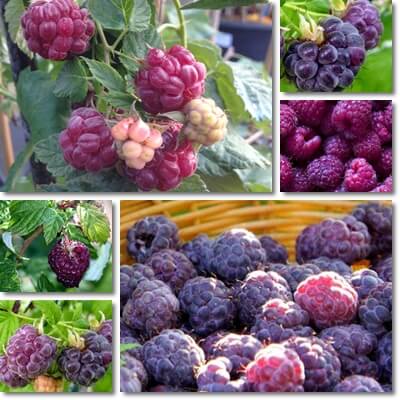Purple raspberries (scientific name: Rubus neglectus) are a cross between red and black raspberries. The species is both cultivated and found occurring naturally in the wild.
Purple raspberries owe their rich plum tones to anthocyanins, a class of pigmented antioxidants with scientifically proven free radical-scavenging properties, anti-inflammatory and antimicrobial activity as well as anticancer effects.
The plum-colored berries also provide good amounts of vitamins C and E, dietary minerals such as copper, iron, manganese and potassium, are low in calories and a great source of dietary fiber.
What are purple raspberries?
Purple raspberries are a hybrid species of raspberry obtained by crossing red and black raspberries. They are known to occur naturally if two red and black raspberry plants are in close proximity to one another which is all that’s needed for natural hybridization. The most commercially important species is Rubus neglectus. Some cultivars are sometimes commonly referred to as ‘blue raspberry’, a name suggestive of the stronger bluish tones in some fruits.
Purple raspberry plants are available for sale in nurseries and popular cultivars include Brandywine, Royalty, Glencoe. Planting, growing and pruning this spectacularly-colored berry isn’t any different from caring for other Rubus species.

What do purple raspberries look like?
The fruits start off light green in color and gradually ripen to a deep reddish-purple or plum color. At their ripest, purple raspberries may have either more pronounced reddish tones or stronger blue tones, depending on the cultivar.
The ripe fruits come off the stalk extremely easy, and without the stem. Because the little stem and the core attached to it stay on the plant, picking the fruit leaves a hollow in them, leaving the raspberry looking like a little empty purplish basket.
Purple and other raspberry colors, including red, black and yellow raspberries are not real berries, but rather aggregate fruits meaning dozens of individual fruits called drupelets clumped together to form what we commonly call a ‘raspberry’.
Each individual drupelet contains a tiny edible seed. One particularity of purple raspberries, and raspberries in general, is that the individual drupelets making up a raspberry are not bound together and separate easily which can cause a very ripe raspberry to simply break down into pieces at the slightest touch.
What do purple raspberries taste like?
Purple raspberries taste quite different from red, yellow and black raspberries. The taste can be described as quite fresh with pleasant sweet and fruity flavors and moderate astringency. The flavor profile is richer than that of red and yellow raspberries, with more complex fruity flavors.
Purple raspberries taste sweeter and less astringent compared to red, but are not as overtly sweet as yellow raspberries. However, their flavor profile is slightly less intense compared to black raspberries. The riper the fruit, the more pronounced the sweetness and the lower the acidity.
Unripe, green purple raspberries will be tough with strong green flavor notes. Underripe fruits, that is, fruits that are not fully ripe may be sour, astringent or tangy beyond what constitutes palatability. Overall purple raspberries have a pleasant flavor reminiscent of both the black and red parent species.
Purple raspberries vs red raspberries (Differences)
What is the difference between purple raspberries and red? For one, purple raspberries are a cross resulting from the hybridization of red and black raspberry species. Other than this, the two varieties of the fruit are quite similar. In addition to a fairly similar nutritional profile, both get their color from pigmented anthocyanin antioxidants. Anthocyanins are essentially pigments in plants that give leaves, flowers and fruits their red, blue, purple or black colors. In red raspberries, they yield deep red colors, whereas in purple ones, they yield purple or plum colors while in black raspberries, a deep and very dark purple-black color.

Nutrition facts of purple raspberries
The nutritional profile of purple raspberries specifically is poorly researched, but the fruit is considered to have a nutritional value that is fairly similar to its red and black color variants.
What this means is that purple raspberries are a good source of vitamin C, vitamin E and vitamin K, but also antioxidant minerals such as copper, manganese and iron.
Limited amounts of other essential vitamins and minerals, including B vitamins, vitamin A and other dietary minerals such as calcium, magnesium, potassium and zinc, are also typically present in all color variants of the fruit.
The ripe berries are further an excellent source of dietary fiber, have a high water content, but low energetic value (roughly 50 kcal, calories per 100 grams of fruit), around 1 gram of protein and almost no fat.
With regards to its antioxidant content, Rubus neglectus is more similar to its darker-colored parent, the black raspberry. It is an important source of dark pigmented anthocyanin antioxidants with impressive therapeutic potential. Other polyphenols include ellagic acid, ellagitannins, catechins, kaempferol, gallic acid etc.
What are the benefits of purple raspberries?
The health benefits of purple raspberries are roughly the same as the health benefits of its parents and may include:
- Constipation relief and other benefits for digestion thanks to a good fiber content.
- Good food for hemorrhoids as a result of fiber content (fiber promotes regular bowel movements).
- Satiating, supports healthy weight loss: in addition to dietary fiber being filling and curbing hunger, the low calorie and fat content further help maintain a steady weight.
- The berries help correct hypoglycemia (low blood sugar levels), but don’t raise blood sugar excessively thanks to a generous fiber content.
- The vitamin E in purple raspberry seeds holds antioxidant and anti-aging benefits for skin as well as nourishes skin and helps it better retain moisture for a more youthful appearance.
- Anti-inflammatory food thanks to vitamins C, E, K, dietary minerals and anthocyanin antioxidants.
- Good food for more energy: carbs and sugar provide quick energy to use, while iron and B vitamins have a revitalizing effect and combat muscle weakness and fatigue.
- Cholesterol-lowering benefits as a result of dietary fiber, vitamin E and anthocyanin antioxidants.
- Blood pressure-lowering benefits from magnesium, potassium and anthocyanin antioxidants.
- Anticancer properties: in vitro studies show anthocyanin antioxidants inhibit proliferation of various cancer cell lines and have anti-mutagenic effects, preventing cell damage.
- Vitamin C in purple raspberries supports the production of collagen which maintains blood vessel elasticity.
- Anthocyanin antioxidants have been shown to support endothelial function for reduced risks of cardiovascular disease.
